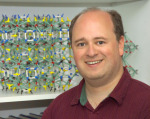Interdigitation, Interpenetration, Intercalation
There is an old adage that "Nature abhors a vacuum". This applies particularly to crystals. When crystals form the molecules try to use up as much of the volume in the crystal as possible. Even when the crystal is forced to form "porous" crystals, when they're first made those pores are usually full of, at the very least, solvent molecules which must be forced out to access and use those pores.
In structures where the molecules form networks, the spaces within the crystal formed by those networks can be minimised through the (un?)holy trinity of crystal packing – interdigitation, interpenetration and intercalation. This is perhaps best illustrated by three structures which, chemically, are very closely related but display very different crystal packing in each case.

All these three structures consist of copper atoms bridged by the small tricyanomethanide anion and another organic ligand, and all three form simple square grid two-dimensional networks. When the organic ligand is hexamethylenetetraamine, the 2D networks are quite corrugated and the anions project above and below the layers like bristles on a brush. So much so, in fact, that they poke into the holes of the adjoining network, and thus the nets interdigitate (literally meaning they have interlocked digits, much like your own digits do when you clasp your hands together).
When the ball-shaped hexamethylenetetraamine is replace by the rod-like 4,4'-bipyridine, the layers interpenetrate rather than interdigitate. This means that (in this case) there are two networks that pass through each other to form discrete layers. The pairs of sheets are not directly connected to each other but are nonetheless interlocked such that they couldn’t be separated without the breaking of bonds. Fortunately this is not the case with interdigitation, or otherwise we'd need surgery every time we clasped our hands together.
If the length of the ligand is extended slightly (by replacing 4,4'-bipyridine with 1,2-trans(4-pyridyl)ethene) the same square grid is formed; however, this time the sheets stack to form channels, and the structure fills the extra space by trapping (intercalating) solvent and 1,2-trans(4-pyridyl)ethene molecules in those channels.
So, on the whole, crystals are quite clever things, with a range of tools in their arsenal when it comes to packing molecules together efficiently. So if we want to make crystals with lots of spaces inside, we need to be even cleverer…
Source: "Interdigitation, Interpenetration and Intercalation in Layered Cuprous Tricyanomethanide Derivatives", S. R. Batten, B. F. Hoskins, R. Robson, Chem. Eur. J., 2000, 6, 156.
CCDC Deposition codes: 118844-118846






